 |
 |
| |
|
| |
Camel Wrestling- Bizarre Sports in Turkey!

|
| |
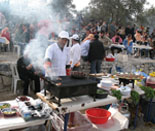 |
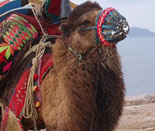 |
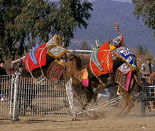 |
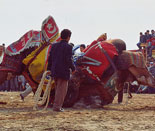 |
|
| |
Understanding Camel Behavior
Camels are considered as sharks of the deserts. They can perfectly
adapt to their environment: their thick foot pads can resist the
roasting sand of the Sahara. Their blood cells can endure impious
dryness, and their scat is so painstakingly drained of valuable
water that can be utilized to stimulate them during fires.
Camel wrestlers in Turkey are considered as body builders of their
species, and they are carefully fed so as to be enormous, and become
more grandiose as they marched through Turkish villages during
winter. They are often decorated with majestic finery, or armored.
Camels appear to take it all in stride and always seem to be
smiling, probably because humanity amuses them.
Camel wrestling in Turkey is one of the most popular sports which
also known to other neighboring countries. We may question why camel
is used in this type of sports. Well, camel is natural wrestlers.
Their humiliating technique is close to the method used by human
wrestlers.
There are techniques how winning camel succeeds in every
fight they come across:
• Catching their neck over their opponent's back.
• Then they haul up their weight off their front feet to move
their weight to their opponent.
• Extend over and take hold of the other front leg of their
opponent using their fighting teeth.
• Bite the legs of their opponent and drag that leg under and
across. It helps them to tumble their opponent.
• Break down the windpipe of the down camel.
Playing sports with an aggressive camel take a lot of courage and
knowledge. One must be aware of the camel’s neck-hooking technique
to avoid getting thrown to the ground. Camels, not like horses, they
can also kick all directions and sideways. Camels are well-formed
martial artists and this is the reason why they are used in sports
that reflect the richness of Turkish traditions.
|
|
| |
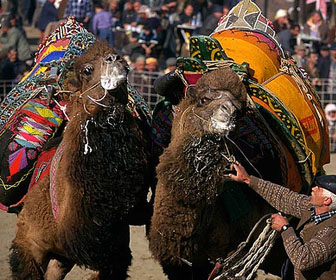 |
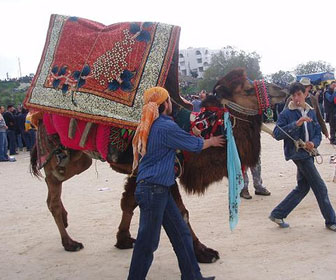
|
|
| |
History of Camel Wrestling
Camel Wrestling is mostly common in the Aegean region of Turkey. It
is also held in the Marmara and Mediterranean regions of the said
country. In Turkey, there are over 1200 camel wrestlers bred
specifically for the competitions. Camel wrestling rules may vary
from different regions. In this kind of sports, it does not require
a special field or spectators because most of the time camel
wrestling competition was held for the purpose of fundraising for
Education, Health, Culture, Sports or Social welfare organizations.
Male camels born to female camels with a single hump or those with
double humps are allowed in this kind of competition. Wrestler
camels are also known as Tulu camel. Pari-mutuel arrangements or
betting were allowed in this competition. The proceeds from the
camel wrestling tournament are used for certain purposes after the
costs are deducted. The camel wrestling is mostly held during the
winter months because during these months the tülüs are in fervor.
Every wrestling camel has its unique name. Camel names were enthused
by how it behaves during wrestling matches or it was named after a
popular character from TV shows like American detective Colombo and
Sahintepesi. The name of the competing camel is written on a piece
of cloth known as a peş and hung behind the saddle called havut. And
beneath its name, the word Maşallah is also written which means “may
God protect him.”
Camel wrestling event includes significant
ceremony. Camel wrestlers are decorated in a manner set down by the
tradition. They are walked through the streets with music played on
drums and zurna on the day before the actual tournament. This event
is very spectacular that everyone should see at least once. Camel
owners were dressed in checkered caps, customary scarves around
their neck, jackets, special pants and boots in an accordion-like
shaped. On the night before the tournament, a Hali Gecesi or Rug
Night was held attended by camel owners and wrestling lovers. This
night is a kind of celebration to meet new friends and old
acquaintances that will help them strengthen the bonds of their
friendship wherein they enjoy the food, drinks and sing their native
songs, dance and sell rugs at an auction.
During the day of the
actual tournament, the wrestling field was filled of spectators and
street sellers offering a variety of food, drinks and souvenirs with
matching band playing drums and zurna. Some people were inspired to
dance the traditional dance zeybek. The cazgir announces the names
of the camels set to compete that marked the start of the contest
proper. He acts as a sports announcer just like in a soccer match.
The cazgir also reads distinct qualities of each camel that adds
color to the contest. He is also the most important and colorful
person in this event. Camels walk a lap around the field before the
start of the wrestling match. In this match, there are three ways to
determine which camel wins; if the camel makes it rival escape from
the field, if the camel draw his rival with different tricks and
games that his rival cannot stand and cries or if the camel makes
his rival fall with tricks and sits on it.
If the camel owner is
more concern to his camel to prevent of being hurt than the victory,
he can throw a rope on the ground which means that he accept defeat
which is also called as pes (means give up). The wrestling match lasts for only
10-15 minutes and wrestler camel can compete once a day. The
victorious camel brings its four feet and greets the audience very
proud and received the rug as his reward and leaves the field while
the loser camel shows stillness and humiliation. Camel wrestling
events are held with both discipline and strong nod to tradition.
The events were concluded with joy and proud as to the owners of the
winning camel and wrestling fans who are all delighted of having a
momentous day.
|
|
| |
|
|
| |
|
<-Back
|
|
|
 |
|
